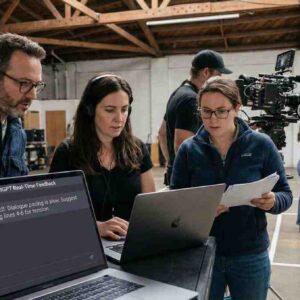Introduction: Revolutionizing the Film Industry
The film industry, with its complex processes and significant financial stakes, is undergoing a transformation thanks to Artificial Intelligence (AI). AI technologies are not only enhancing creative outputs but also streamlining production processes and cutting costs significantly. This integration is reshaping how movies are made, from pre-production planning to post-production editing.
1. Pre-production Planning
AI excels in the pre-production phase by optimizing planning and logistics. AI-powered software can analyze script content to provide estimates on production costs, helping producers make informed budgeting decisions. For example, AI can quickly scan a script to determine the number of locations, special effects, and extras needed, predicting logistical needs and potential bottlenecks. This precision in early stages helps in allocating resources more efficiently, potentially saving substantial amounts of money.
2. Casting and Crew Assembly
AI tools streamline the casting process by using predictive analytics to suggest actors who best fit the characters’ profiles and are most likely to appeal to the target audience. Similarly, AI can assist in assembling the right crew for the project by analyzing past performance data and compatibility scores based on previous collaborations. This not only speeds up the hiring process but also enhances team dynamics and project outcomes.
3. On-Set Efficiency
During filming, AI technologies contribute to on-set efficiency in several ways. AI-driven cameras can automate certain shots, adjust lighting based on pre-set conditions, and even track continuity issues, reducing the need for retakes. AI can also manage complex data from daily shoots, syncing them with cloud servers for real-time access and backups, ensuring that all data is immediately available for review and editing.
4. Post-Production Enhancements
In post-production, AI significantly reduces the time and cost associated with editing, special effects, and sound design. AI algorithms can automatically edit footage based on pre-programmed criteria such as shot length, actor performance, and emotional tone, providing a rough cut much faster than traditional methods. Additionally, AI can generate realistic visual effects and soundtracks by learning from existing databases, reducing the reliance on expensive VFX studios and sound design consultants.
5. Marketing and Distribution
AI’s role extends to the marketing and distribution phases by analyzing viewer data to create targeted marketing campaigns. By understanding audience preferences and behaviors, AI can suggest the most effective platforms and times for trailer releases, promotional events, and the film’s actual release. Furthermore, AI can predict the best distribution strategies to maximize audience reach and box office returns, customizing release strategies across different regions based on local audience data.
Challenges and Ethical Considerations
While AI presents numerous advantages, it also raises ethical concerns, particularly regarding job displacement and data privacy. There is fear that AI could replace jobs in areas like editing and camera operation. Moreover, the use of extensive data for audience analysis must be handled with care to respect viewer privacy and prevent bias.
Conclusion: Embracing AI in Film Production
AI is set to play an increasingly central role in film production, offering tools that streamline processes, enhance creativity, and reduce costs. As the industry continues to evolve, filmmakers must navigate the challenges and opportunities presented by AI with a balanced approach. By doing so, the film industry can harness AI’s potential to not only improve efficiency and reduce costs but also to foster new and innovative ways of storytelling.













